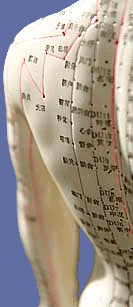MYOFASICAL PAIN SYNDROMES - THEORIES
The Trigger Point Story – Where East Meets West
Traditional Chinese Medicine
“Where there is a painful spot, there is an Acupuncture point” from the Neijing- The Yellow Emperor’s Classic -500 B.C.
“When pressed on the Patient winces, or suddenly starts and exclaims AAGH Is The POINT!” From Acupuncture a Comprehensive Text: Shanghai College of Traditional Chinese medicine.
“Ah Shi – Oh Yes!” as the patient’s pain complaint is reproduced by palpation. Nanking College of Traditional Chinese Medicine, Nanking, China 1978.
Traditional Chinese Medicine groups Myofascial Pain Syndromes under the heading of Cold Bi syndromes.

Traditional Chinese Medicine’s pathogenic factors include
- Over-exertion
- Invasion by “Cold” E.g. Chilling of a muscle by wind or cold following exertion.
- Prolonged Inactivity
- Visceral disturbance
Cold Bi syndromes have these common characteristics: Inhibition of blood supply, fondness and alleviation of pain with warmth and a worsening of pain severity with cold and damp.
Traditional Chinese Medicines aim in the treatment of Cold Bi is to remove the obstruction to the flow of Chi and blood and warm and nourish the tissues.
In Western terms, remove the trigger point and its associated muscle spasm/shortening, diminish the over active sympathetic outflows and thereby restore normal blood flow.
The Near and Far method of Acupuncture, where the tender point/trigger point, plus distal analgesia producing sympatholytic acupuncture points below the elbow or knee are needled with the Bu technique, is an ancient method for the treatment of Myofascial pain syndromes that is currently used in China today.
The Bu needling technique, or the warming method, where the needle is painlessly inserted and gently manipulated until needle grasp is obtained provokes stimulation of large sensory nerve fibers.The consequences of large fiber afferent activity are inhibition of small fiber activity (pain gate), relaxation of segmental muscle tone (muscle gate), and inhibition of sympathetic segmental outflow (sympathetic gate).
The exact effects of trigger point needling are not known. Relaxation of ‘stuck’ myofibrils, segmental release of endogenous opioids (dynorphin, encephalin), and localized trauma induced vasodilatation have all been postulated to explain the return to normal of an exquisitely tender circumscribed muscle area.
The effect of needling the analgesia producing distal points (points that are either muscle motor points or have dense cutaneous / muscle nerve innervation) has been well researched. The analgesic effects are mediated by the Endogenous Opioids substances as well as a host of other neurotransmitters and modulators including 5HT, and Nor Adrenaline. The sympatholytic effects of Acupuncture have also been well detailed and have been shown to be associated with decreased pain scores in both sympathetically maintained and trigger point related pain states.
The success of the Near and Far Acupuncture technique and indeed of most treatment techniques that target the trigger point relies on the accurate localization of the relevant trigger point. Consequently a rigorous physical examination including palpation must be carried out.
The practitioner’s level of skill and training also appear to be influential, as does the adherence to classical treatment schedules. These factors seem to have been alluded to by Richardson and Vincent in their review article “Acupuncture for the Treatment of Pain: a Review of Evaluative Research” PAIN, 24 (1986) 15 – 40, when discussing the long term pain relieving effects of acupuncture; “The controlled study by Coan et al., where traditional acupuncturists were given the freedom to follow their normal practices, presents a more promising picture- with improvements in 58% of the initial sample of low back pain patients being maintained at a 10 month follow-up.”

That these factors may be of lesser importance in the short-term effectiveness of Acupuncture may be deduced from their statement, “The above review indicates that there is good evidence from controlled studies for the short-term effectiveness of acupuncture in relieving clinical pain in each of the areas examined. The extent of the therapeutic effects produced has varied from study to study but the proportion of patients helped has commonly fallen in the 50 – 80% range. This applies to both acute and chronic painful conditions.” as many of the trials surveyed utilized Acupuncture regimes that bear little resemblance to Acupuncture as it is practiced in China today.
Western Treatment
The effective Rx of Myofascial Pain rests with defining the tissue and or reflex that is maintaining the Pain State. I.e. find the ‘Active Trigger Points’ and assess sympathetic involvement.
However, before being able to effectively treat Myofascial Pain syndromes (and evaluate that treatment’s efficacy) the Trigger Point must first be identified, quantified and its associated reflexes delineated. Pressure Algometry, Thermography and EMG studies as well as electrical stimulation pain provocation studies and differential local anesthetic blocks, have been used with varying success to provide objective measurement of Trigger Point activity. Additionally much can be gained in clinical practice by the use of subjective pain assessment tools including, Visual Analogue pain Scales, The McGill Pain Questionnaire and Pain Diagrams.
The wide importance of Pain Assessment is highlighted by the following statement: “One of the most dramatic developments in pain research and therapy has been the recent proliferation of techniques for the measurement and assessment of Pain”, -R. Melzack.
My own view is that, every patient complaining of chronic pain deserves to be examined. Palpation and the utilization of pain assessment tools including, Pain Diagrams, the McGill Pain Questionnaire, Visual Analogue Pain Scale are all a necessary part of this process. and should always be carried out before referral for psychologically based therapies. Simon Strauss unsubstantiated opinion.
Contact Us
13710 Olive Boulevard (Primary Office)
Chesterfield, MO 63017
Telephone: 314-469-PAIN (7246)
Fax: 314-469-7251
Exchange: 314-441-6965 (for after-hour Emergencies Only)
Hours:
Monday thru Friday
8:30 AM – 4:30 PM

